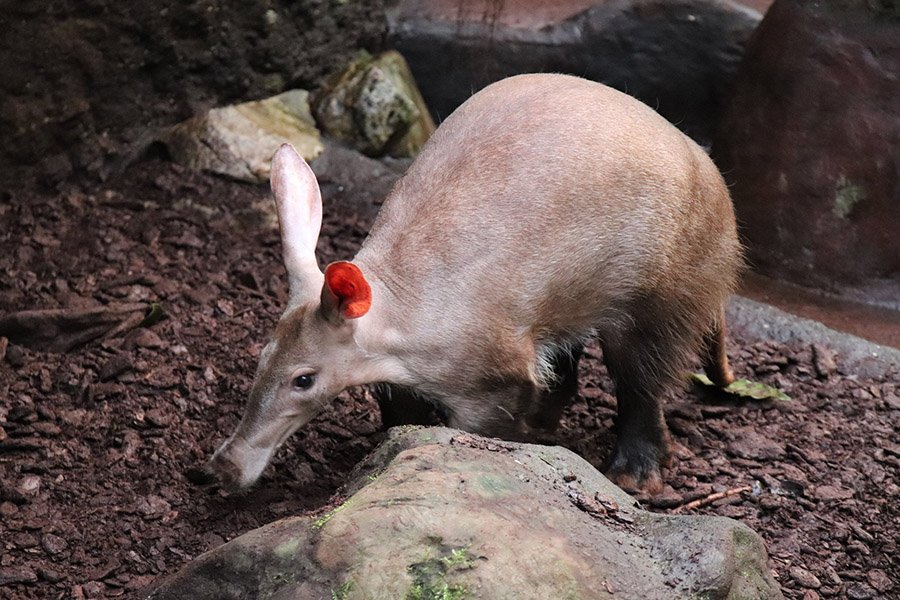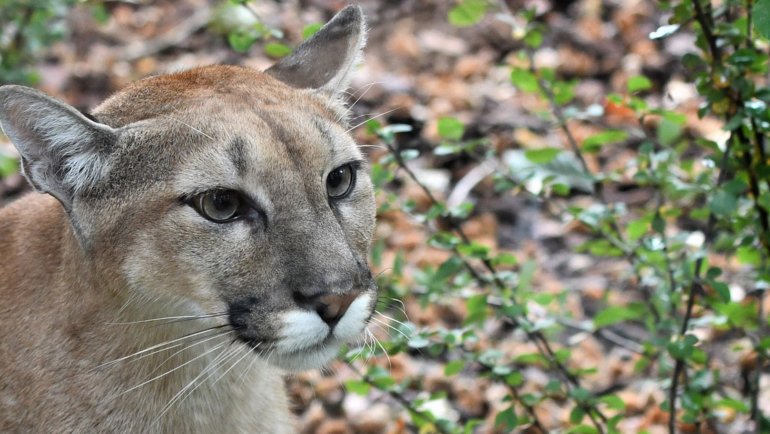The aardvark is for sure an intriguing and often overlooked creature. With its nocturnal habits, unusual appearance, and secretive lifestyle, it is not the easiest animal to observe and study.
In this article, explore what we know about aardvarks, first providing essential information about this extraordinary animal, and then listing 22 cool facts that I am sure you will love.
Without further ado, let’s get started with our aardvark facts!
Contents
show
Essential Information About The Aardvark
- Scientific name: Orycteropus afer
- Type of Animal: Mammal
- Size: 105-130 cm (3.44-4.27 ft), up to 2.2 m (7.2 ft).
- Weight: 50-82 kg (110-180 lbs)
- Distribution: Sub-saharan Africa
- Habitat: Savannas, grasslands, bushlands, woodlands
- Diet: Almost exclusively ants and termites, and sometimes a fruit called “the aardvark’s cucumber”.
- Predators: Lions, hyenas, leopards, wild dogs.
- Reproduction: They give birth to one, sometimes two cubs after a 7-8- month gestation. Northern populations give birth in October-November, and southern populations between May and July.
- Conservation status: Least Concern.
 Source: Ewen Roberts / Flickr
Source: Ewen Roberts / Flickr21 Cool Facts About The Aardvark
- Aardvarks are the sole living species in the order Tubulidentata, making them truly unique among mammals. “Tubulidentata” means “tubular teeth”, and reflects the uniqueness of their dental structure, making aardvarks even more one-of-a-kind. Learn more about their teeth in the second fact:
- Instead of front incisors or canines, aardvarks have 20 tubular teeth situated at the back of their jaw, which they use to grind up the insects they consume. Instead of enamel, their teeth are made up of tightly packed, hexagonal tubes of dentin. This specialized dental structure is an adaptation to their insectivorous diet, allowing them to efficiently process large quantities of ants and termites.
- Aardvarks possess remarkable digging abilities, enabling them to excavate burrows up to 10 meters (33 feet) long. These extensive tunnel systems provide safe and comfortable living spaces for aardvarks, allowing them to escape predators and harsh environmental conditions. The burrows also serve as breeding grounds, ensuring the continued survival of their species.
- Despite their pig-like appearance, aardvarks share a closer genetic relationship with elephants, manatees, and hyraxes. Researchers have found that these animals share a common ancestor. It goes to show how fascinating and diverse the animal kingdom is! Contrary to what some people believe, they have no relations with anteaters.
- Aardvarks are known to dig temporary burrows for various purposes, such as evading predators or escaping extreme temperatures. In contrast to their primary burrows, which are used for breeding and long-term shelter, these temporary hideouts serve as short-term protection, ensuring the aardvark’s safety in times of danger or discomfort.
 Source: heights.18145 / Flickr
Source: heights.18145 / Flickr- Aardvarks have relatively poor eyesight, but their highly developed hearing and sense of smell compensate for this deficiency. These senses help them locate food sources, such as ant and termite mounds, while also enabling them to detect approaching predators and respond quickly to potential threats.
- Baby aardvarks, referred to as “cubs” or “pups,” are born with soft, folded skin that hardens as they mature. This unique feature provides the young aardvarks with some protection against the rough terrain and potential threats they encounter in their early life. As they grow older, their skin becomes tougher, offering increased protection and support.
- Aardvarks are skilled swimmers and can traverse bodies of water even with strong currents. This ability allows them to expand their range and access new sources of food or shelter. Their swimming prowess demonstrates the adaptability of these creatures in navigating various environments, contributing to their survival in the wild.
- Numerous species, such as warthogs, porcupines, and African wild dogs, are known to utilize old aardvark burrows as homes. By reusing these abandoned structures, these animals conserve energy and resources, and aardvarks indirectly contribute to the well-being of other species within their ecosystem, fostering diversity and interdependence.
- The aardvark’s tail bears a resemblance to a kangaroo’s tail, which it employs for balance when standing on its hind legs. This adaptation allows them to maintain stability when digging, foraging, or even engaging in defensive behavior. The versatile tail demonstrates the many ways that aardvarks have evolved to navigate their environment effectively.
 Source: Richard Gillin / Flickr
Source: Richard Gillin / Flickr- Aardvarks can cover vast distances in search of food, traveling up to 10 miles in a single night. This remarkable range allows them to access various sources of food and adapt to the changing availability of ants and termites. Their ability to travel such distances highlights their resilience and adaptability, enabling them to survive and thrive in the diverse habitats of sub-Saharan Africa.
- Aardvarks are nocturnal creatures, which means they are active during nighttime hours and rest during the day to conserve energy. This nocturnal behavior helps them avoid the heat of the African sun and reduces their risk of encountering predators that are more active during daylight hours.
- Aardvarks are native to sub-Saharan Africa, where they can be found in various habitats such as grasslands, savannas, and woodlands. Their adaptability to diverse environments is a testament to their resilience and ability to thrive in different ecological conditions.
- The name “aardvark” comes from the Afrikaans language and translates to “earth pig.” This name is derived from their pig-like snouts and burrowing habits, which are reminiscent of how pigs dig for food with their snouts. The name also highlights their strong connection to the earth, as they spend much of their time digging and living in burrows.
- Aardvarks are solitary creatures, preferring to live alone and only interacting with other aardvarks during the mating season. This solitary lifestyle helps them avoid competition for food and resources, allowing them to maintain their energy and focus on survival.

- Aardvarks have a remarkable appetite, capable of consuming up to 50,000 ants and termites in a single night. Their 30 cm-long sticky tongue allows them to collect large quantities of insects quickly and efficiently, providing them with the necessary nutrients and energy to sustain their nocturnal activities.
- Aardvarks have the unique ability to seal their nostrils while foraging, preventing dust and ants from entering their nasal passages. This adaptation allows them to focus on feeding without the risk of inhaling debris or insects that may cause irritation or discomfort.
- Aardvarks use their strong stomach muscles to grind up their food, compensating for their lack of front teeth. This powerful muscular action enables them to break down the exoskeletons of insects, making it easier for them to digest and absorb nutrients.
- Adult aardvarks can weigh up to 180 pounds (82 kg). This relatively large body size allows them to store more energy reserves, which can be helpful during periods of food scarcity or when they need to escape from predators.
- Aardvarks have a unique gait that combines elements of a waddle and a gallop. This unusual movement pattern helps them navigate their varied habitats and enables them to cover long distances while foraging for food.
- Aardvarks are territorial animals and use scent glands located near their tails to mark their territory. This behavior helps them establish and maintain their personal space, reducing competition for resources and potential conflicts with other aardvarks.
Top image: Wikimedia Commons
Other Articles To Learn More About Aardvarks
- What Do Aardvarks Eat? All About Aardvarks’ Diet
- Where Do Aardvarks Live? Range, Habitat & How To See Them
- Are Aardvarks Endangered? What You Need to Know
- What is a Group of Aardvarks Called? Do They Actually Live in Groups?
- Aardvark vs. Anteater – What Are Their Key Differences?
References
- https://www.nationalgeographic.com/animals/mammals/facts/aardvark
- https://www.iucnredlist.org/species/41504/21286437
- https://en.wikipedia.org/wiki/Aardvark
- https://www.thoughtco.com/10-facts-about-aardvarks-4129429
- https://africageographic.com/stories/9-amazing-facts-about-aardvarks/
- https://www.worldsfacts.com/35-interesting-facts-about-aardvarks/
- https://onekindplanet.org/animal/aardvark/
- https://www.awf.org/wildlife-conservation/aardvark





